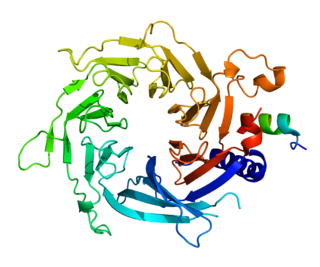Methyl-CpG-binding domain protein 3 is a protein that in humans is encoded by the MBD3 gene. [5] [6] [7]
Methyl-CpG-binding domain protein 3 is a protein that in humans is encoded by the MBD3 gene. [5] [6] [7]
DNA methylation is the major modification of eukaryotic genomes and plays an essential role in mammalian development. Human proteins MECP2, MBD1, MBD2, MBD3, and MBD4 comprise a family of nuclear proteins related by the presence in each of a methyl-CpG binding domain (MBD). However, unlike the other family members, MBD3 is not capable of binding to methylated DNA but instead binds to hydroxymethylated DNA. [8] The predicted MBD3 protein shares 71% and 94% identity with MBD2 (isoform 1) and mouse Mbd3. MBD3 is a subunit of the NuRD, a multisubunit complex containing nucleosome remodeling and histone deacetylase activities. MBD3 mediates the association of metastasis-associated protein 2 (MTA2) with the core histone deacetylase complex. [7]
MBD3 also contains the coiled‐coil domain common to all three MBD3 isoforms. The coiled‐coil domain, but not the MBD domain, helps to maintain pluripotency of embryonic stem cells via the recruitment of polycomb repressive complex 2 to a subset of genes linked to development and organogenesis, thus establishing stable transcriptional repression. [9]
MBD3 has been shown to interact with:

Methyl-CpG-binding domain protein 1 is a protein that in humans is encoded by the MBD1 gene. The protein encoded by MBD1 binds to methylated sequences in DNA, and thereby influences transcription. It binds to a variety of methylated sequences, and appears to mediate repression of gene expression. It has been shown to play a role in chromatin modification through interaction with the histone H3K9 methyltransferase SETDB1. H3K9me3 is a repressive modification.

Histone deacetylase 1 (HDAC1) is an enzyme that in humans is encoded by the HDAC1 gene.

Histone deacetylase 2 (HDAC2) is an enzyme that in humans is encoded by the HDAC2 gene. It belongs to the histone deacetylase class of enzymes responsible for the removal of acetyl groups from lysine residues at the N-terminal region of the core histones. As such, it plays an important role in gene expression by facilitating the formation of transcription repressor complexes and for this reason is often considered an important target for cancer therapy.

Histone deacetylase 3 is an enzyme encoded by the HDAC3 gene in both humans and mice.

Paired amphipathic helix protein Sin3a is a protein that in humans is encoded by the SIN3A gene.

Histone-binding protein RBBP4 is a protein that in humans is encoded by the RBBP4 gene.

Histone deacetylase 4, also known as HDAC4, is a protein that in humans is encoded by the HDAC4 gene.

Histone-lysine N-methyltransferase SUV39H1 is an enzyme that in humans is encoded by the SUV39H1 gene.

Methyl-CpG-binding domain protein 2 is a protein that in humans is encoded by the MBD2 gene.

Metastasis-associated protein MTA1 is a protein that in humans is encoded by the MTA1 gene. MTA1 is the founding member of the MTA family of genes. MTA1 is primarily localized in the nucleus but also found to be distributed in the extra-nuclear compartments. MTA1 is a component of several chromatin remodeling complexes including the nucleosome remodeling and deacetylation complex (NuRD). MTA1 regulates gene expression by functioning as a coregulator to integrate DNA-interacting factors to gene activity. MTA1 participates in physiological functions in the normal and cancer cells. MTA1 is one of the most upregulated proteins in human cancer and associates with cancer progression, aggressive phenotypes, and poor prognosis of cancer patients.

Histone-binding protein RBBP7 is a protein that in humans is encoded by the RBBP7 gene.

Histone deacetylase 5 is an enzyme that in humans is encoded by the HDAC5 gene.

Histone deacetylase 9 is an enzyme that in humans is encoded by the HDAC9 gene.

Eukaryotic translation initiation factor 3 subunit A (eIF3a) is a protein that in humans is encoded by the EIF3A gene. It is one of the subunits of Eukaryotic initiation factor 3 (eIF3) a multiprotein complex playing major roles in translation initiation in eukaryotes.

Sin3A-associated protein, 30kDa, also known as SAP30, is a protein which in humans is encoded by the SAP30 gene.

Chromodomain-helicase-DNA-binding protein 4 is an enzyme that in humans is encoded by the CHD4 gene.

Metastasis-associated protein MTA2 is a protein that in humans is encoded by the MTA2 gene.

Histone H4 transcription factor is a protein that in humans is encoded by the HINFP gene.

Chromobox protein homolog 5 is a protein that in humans is encoded by the CBX5 gene. It is a highly conserved, non-histone protein part of the heterochromatin family. The protein itself is more commonly called HP1α. Heterochromatin protein-1 (HP1) has an N-terminal domain that acts on methylated lysines residues leading to epigenetic repression. The C-terminal of this protein has a chromo shadow-domain (CSD) that is responsible for homodimerizing, as well as interacting with a variety of chromatin-associated, non-histone proteins.
In the field of molecular biology, the Mi-2/NuRDcomplex, is a group of associated proteins with both ATP-dependent chromatin remodeling and histone deacetylase activities. As of 2007, Mi-2/NuRD was the only known protein complex that couples chromatin remodeling ATPase and chromatin deacetylation enzymatic functions.